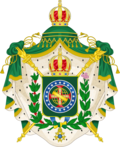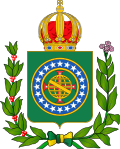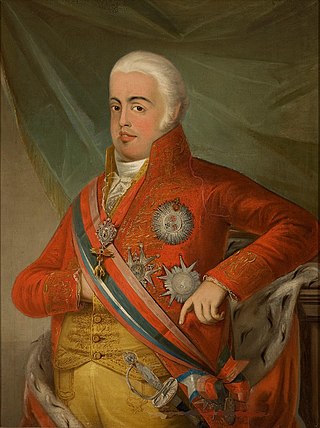
Dom John VI, nicknamed "the Clement", was King of the United Kingdom of Portugal, Brazil and the Algarves from 1816 to 1825. Although the United Kingdom of Portugal ceased to exist de facto beginning in 1822, he remained its monarch de jure between 1822 and 1825. After the recognition of the independence of Brazil under the Treaty of Rio de Janeiro of 1825, he continued as King of Portugal until his death in 1826. Under the same treaty, he also became titular Emperor of Brazil for life, while his son, Emperor Pedro I, was both de facto and de jure the monarch of the newly independent country.
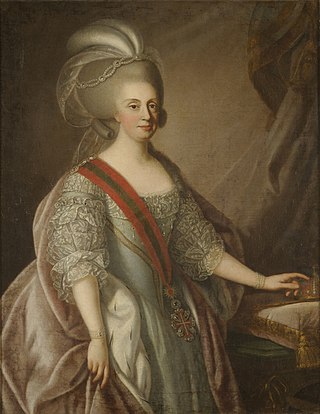
Dona Maria I was Queen of Portugal from 24 February 1777 until her death in 1816. Known as Maria the Pious in Portugal and Maria the Mad in Brazil, she was the first undisputed queen regnant of Portugal and the first monarch of Brazil.

The Most Serene House of Braganza, also known as the Brigantine dynasty, is a dynasty of emperors, kings, princes, and dukes of Portuguese origin which reigned in Europe and the Americas.
Prince of Beira is a title traditionally granted to the heir apparent to the throne of Portugal. The title's original use that it be granted on the eldest daughter of the reigning monarch of Portugal. Tied with the title of Prince of Beira, is Duke of Barcelos, as heir to the Duke of Braganza and Prince of Brazil. The title's name has its origins in the Beira province in central Portugal.
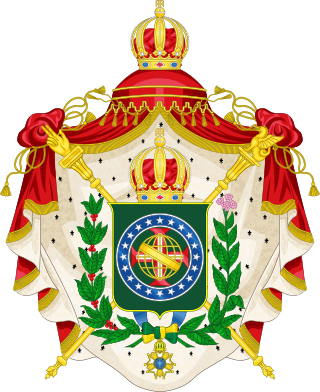
The Imperial House of Brazil is a Brazilian dynasty of Portuguese origin that ruled the Brazilian Empire from 1822 to 1889, from the time when the then Prince Royal Dom Pedro of Braganza declared Brazil's independence, until Dom Pedro II was deposed during the military coup that led to the Proclamation of the Republic in 1889.
Imperial and Royal Majesty was the style used by Emperor-Kings and their consorts as heads of imperial dynasties that were simultaneously royal. The style was notably used by the Emperor of Austria and by the German Emperor. The Austrian, German, and Bohemian monarchies were abolished in 1918 while the vacant throne of Hungary continued to exist until the 1940s.

This is a historical timeline of Portugal.

The history of the kingdom of Portugal and the Algarves, from the First Treaty of San Ildefonso and the beginning of the reign of Queen Maria I in 1777, to the end of the Liberal Wars in 1834, spans a complex historical period in which several important political and military events led to the end of the absolutist regime and to the installation of a constitutional monarchy in the country.
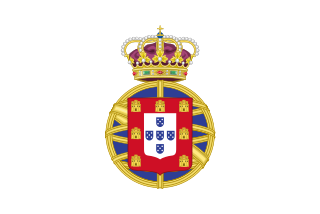
The United Kingdom of Portugal, Brazil and the Algarves was a pluricontinental monarchy formed by the elevation of the Portuguese colony named State of Brazil to the status of a kingdom and by the simultaneous union of that Kingdom of Brazil with the Kingdom of Portugal and the Kingdom of the Algarves, constituting a single state consisting of three kingdoms.

The Kingdom of Portugal was a monarchy in the western Iberian Peninsula and the predecessor of the modern Portuguese Republic. Existing to various extents between 1139 and 1910, it was also known as the Kingdom of Portugal and the Algarves after 1415, and as the United Kingdom of Portugal, Brazil and the Algarves between 1815 and 1822. The name is also often applied to the Portuguese Empire, the realm's overseas colonies.
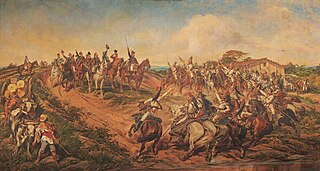
The independence of Brazil comprised a series of political and military events that led to the independence of the Kingdom of Brazil from the United Kingdom of Portugal, Brazil and the Algarves as the Brazilian Empire. It is celebrated on 7 September, the date when prince regent Pedro of Braganza declared the country's independence from the United Kingdom of Portugal, Brazil and the Algarves on the banks of the Ipiranga brook in 1822 on what became known as the Cry of Ipiranga. Formal recognition by Portugal came with the Treaty of Rio de Janeiro, signed in 1825.

The Liberal Revolution of 1820 was a Portuguese political revolution that erupted in 1820. It began with a military insurrection in the city of Porto, in northern Portugal, that quickly and peacefully spread to the rest of the country. The Revolution resulted in the return in 1821 of the Portuguese court to Portugal from Brazil, where it had fled during the Peninsular War, and initiated a constitutional period in which the 1822 Constitution was ratified and implemented. The movement's liberal ideas had an important influence on Portuguese society and political organization in the nineteenth century.

The Kingdom of Brazil was a constituent kingdom of the United Kingdom of Portugal, Brazil, and the Algarves.

The Portuguese royal court transferred from Lisbon to the Portuguese colony of Brazil in a strategic retreat of queen Maria I of Portugal, prince regent John, the Braganza royal family, its court, and senior officials, totaling nearly 10,000 people, on 27 November 1807. The embarkment took place on the 27th, but due to weather conditions, the ships were only able to depart on 29 November. The Braganza royal family departed for Brazil just days before Napoleonic forces invaded Portugal on 1 December 1807. The Portuguese crown remained in Brazil from 1808 until the Liberal Revolution of 1820 led to the return of John VI of Portugal on 26 April 1821.

The Pantheon of the House of Braganza, also known as the Pantheon of the Braganzas, is the final resting place for many of the members of the House of Braganza, located in the Monastery of São Vicente de Fora in the Alfama district of Lisbon, Portugal. The pantheon's burials have included Portuguese monarchs, Brazilian monarchs, a Romanian monarch, queen consorts of Portugal, and notable Infantes of Portugal, among others.

The Portuguese crown jewels, also known as the Royal Treasure, are the pieces of jewelry, regalia, and vestments that were used by the Kings and Queens of Portugal during the time of the Portuguese Monarchy. Over the nine centuries of Portuguese history, the Portuguese crown jewels have lost and gained many pieces. Most of the current set of the Portuguese crown jewels are from the reigns of King João VI and King Luís I.

The Descendants of John VI of Portugal, of the House of Braganza, would play a role in Portuguese imperial affairs, global royalty, and major historical events of their time. John's marriage to Carlota Joaquina of Spain, which was not a content one, produced many children who became key players in the world at their time.
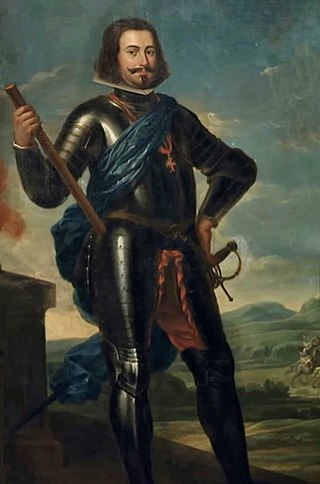
The Curse of the Braganzas is a myth, referred to in several historical chronicles, concerning the House of Braganza, that ruled the Kingdom of Portugal (1640–1910), the United Kingdom of Portugal, Brazil and the Algarves (1815–1822) and the Empire of Brazil (1822–1889) and, therefore, all the Portuguese Overseas Empire.
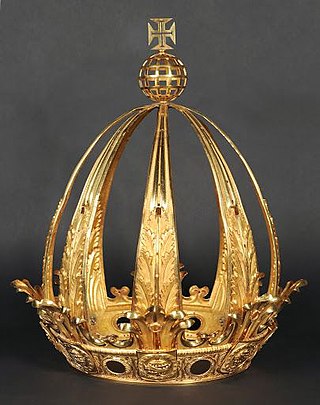
The crown of Pedro I is the first imperial crown of Brazil and was made for emperor Pedro I of Brazil. It was made in 1822 for his coronation and was the symbol and emblem of Brazilian imperial power until it was replaced in 1841 by the crown of his son and successor Pedro II. It is one of the jewels of the Brazilian Empire and is now on display at the Imperial Museum in Petrópolis.
